Boeing 314 Clipper
The Boeing 314 Clipper was an American long-range flying boat produced by Boeing from 1938 to 1941. One of the largest aircraft of its time, it had the range to cross the Atlantic and Pacific oceans. For its wing, Boeing re-used the design from the earlier XB-15 bomber prototype. Twelve Clippers were built, nine of which served with Pan Am.
| Boeing 314 Clipper | |
|---|---|
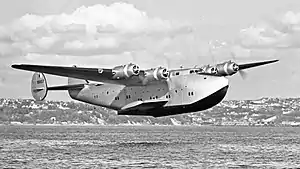 | |
| A Boeing 314 flying low | |
| Role | Flying boat airliner |
| National origin | United States |
| Manufacturer | Boeing Airplane Company |
| First flight | June 7, 1938 |
| Introduction | 1939 |
| Retired | 1948 |
| Status | Retired |
| Primary users | Pan American World Airways British Overseas Airways Corporation United States Navy |
| Produced | 1938–1941 |
| Number built | 12 |
Design and development
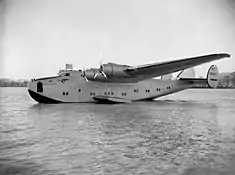
Pan American had requested a truly trans-Pacific flying boat with unprecedented range and double the passenger payload of the airline's Martin M-130. Boeing's bid was successful and on July 21, 1936, Pan American signed a contract for six. Boeing engineers adapted the cancelled XB-15's 149 ft (45 m) wing, and replaced the 850 hp (630 kW) Pratt & Whitney Twin Wasp radial engines with the 1,600 hp (1,200 kW) Wright Twin Cyclone.[1] Pan Am ordered six more aircraft with increased engine power and capacity for 77 daytime passengers as the Boeing 314A.
The huge flying boat was assembled at Boeing's Plant 1 on the Duwamish River in Seattle, and towed to Elliott Bay for taxi and flight tests. The first flight was on June 7, 1938, piloted by Edmund T. "Eddie" Allen. At first the aircraft had a single vertical tail, and Allen found he had inadequate directional control. The aircraft returned to the factory and was fitted with the endplates on the ends of the horizontal tail in place of the single vertical fin. This too was found to be insufficient and finally the centerline vertical fin was restored, after which the aircraft flew satisfactorily.[2]
The 314 used a series of heavy ribs and spars to create a robust fuselage and cantilevered wing, eliminating the need for external drag-inducing struts to brace the wings. Boeing also incorporated Dornier-style sponsons into the hull structure.[3] The sponsons, broad lateral extensions at the waterline on both sides of the hull, served several purposes: They provided a wide platform to stabilize the craft while floating, they acted as a gangway for boarding and exiting, and they possessed intentional shaping to contribute additional aerodynamic lift in flight.
To fly the long ranges needed for trans-Pacific service, the 314 carried 4,246 US gallons (16,070 L; 3,536 imp gal) of gasoline. The later 314A model carried a further 1,200 US gallons (4,500 L; 1,000 imp gal). A capacity of 300 US gallons (1,100 L; 250 imp gal) of oil was required for operation of the radial engines.
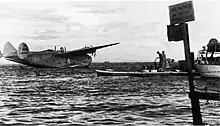
Pan Am's "Clippers" were built for "one-class" luxury air travel, a necessity given the long duration of transoceanic flights. The seats could be converted into 36 bunks for overnight accommodation; with a cruising speed of 188 miles per hour (303 km/h) (typically flights at maximum gross weight were flown at 155 miles per hour (249 km/h)) in 1940, Pan Am's schedule San Francisco to Honolulu was 19 hours. Clipper service catered to elite businessmen and the wealthy traveler. The 314s had a lounge and dining area, and the galleys were crewed by chefs from four-star hotels. Men and women were provided with separate dressing rooms, and white-coated stewards served five and six-course meals with gleaming silver service. The standard of luxury on Pan American's Boeing 314s has rarely been matched on heavier-than-air transport since then. A round trip from New York to Southampton was $675 (equivalent to $14,000 in 2022),[4] while a one-way ticket from San Francisco to Hong Kong via the "stepping-stone" islands posted at $760 (equivalent to $16,000 in 2022).[5] The Pan Am Boeing 314 Clippers brought exotic destinations like the Far East within reach of air travelers and came to represent the romance of flight. Most of the flights were transpacific, while transatlantic flights to neutral Lisbon and Ireland continued after war broke out in Europe in September 1939 (and until 1945), but military passengers and cargoes necessarily got priority, and the service was more spartan.
Equally critical to the 314's success was the proficiency of its Pan Am flight crews, who were extremely skilled at long-distance, over-water flight operations and navigation. For training, many of the transpacific flights carried a second crew.[6] Only the very best and most experienced flight crews were assigned Boeing 314 flying boat duty. Before coming aboard, all Pan Am captains as well as first and second officers had thousands of hours of flight time in other seaplanes and flying boats. Rigorous training in dead reckoning, timed turns, judging drift from sea current, celestial navigation, and radio navigation were conducted. In conditions of poor or no visibility, pilots sometimes made successful landings at fogged-in harbors by landing out to sea, then taxiing the 314 into port.[7]
Operational history
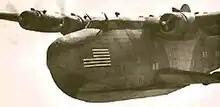
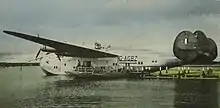
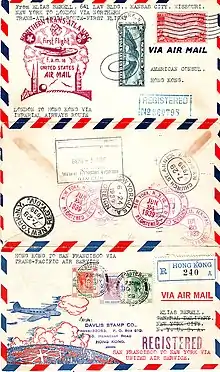
The first 314 flight on the San Francisco-Hong Kong route left Alameda on February 23, 1939 with regular passenger and Foreign Air Mail Route #14 service beginning on March 29.[8][9][10] A one-way trip on this route took over six days to complete. Commercial passenger service lasted less than three years, ending when the United States entered World War II in December 1941. Passengers and their baggage were weighed, with each passenger allowed up to 77 pounds (35 kg) free baggage allowance (in the later 314 series) but then charged $3.25 per pound ($7.2/kg) (equivalent to $68 in 2022) for exceeding the limit.[11]
The Yankee Clipper flew across the Atlantic on a route from Southampton to Port Washington, New York with intermediate stops at Foynes in Ireland, Botwood in Newfoundland, and Shediac, New Brunswick. The inaugural trip occurred on June 24, 1939.
The success of the six initial Clippers had led Pan Am to place an order for six improved 314A models to be delivered in 1941, with the goal of doubling the service on both Atlantic and Pacific routes. However, the fall of France in 1940 caused some doubt about whether the Atlantic service could continue; passenger numbers were already reduced by the war, and if Spain or Portugal were to join the Axis, then the flights to Lisbon would be forced to stop. Pan Am began to consider reducing its order and, in August 1940, reached an agreement to sell three of the six under construction to the United Kingdom. The aircraft were to be operated by the British Overseas Airways Corporation (BOAC) and were primarily intended for the UK – West Africa route, as existing flying boats could not travel this route without stopping in Lisbon. The sale made a small net profit for Pan Am – priced at cost plus 5% – and provided a vital communications link for Britain, but was politically controversial. In order to arrange the sale, the junior minister Harold Balfour had to agree to the contract with no government approval, leading to stern disapproval from Winston Churchill and lengthy debate by the Cabinet over the propriety of the purchase.[12] Churchill later flew on the Bristol and Berwick,[13] which he praised intensely,[12] adding to the Clippers’ fame during the war.[14]
At the outbreak of the war in the Pacific in December 1941, the Pacific Clipper was en route to New Zealand from San Francisco. Rather than risk flying back to Honolulu and being shot down by Japanese fighters, it was directed to fly west to New York. Starting on December 8, 1941 at Auckland, New Zealand, the Pacific Clipper covered over 31,500 mi (50,700 km) via locations including Surabaya, Karachi, Bahrain, Khartoum and Leopoldville. The Pacific Clipper landed at Pan American's LaGuardia Field seaplane base at 7:12 on the morning of January 6, 1942.[15]
Pan Am's Clipper fleet was pressed into US military service during World War II, and the flying boats were used for ferrying personnel and equipment to the European and Pacific fronts. The aircraft were purchased by the War and Navy Departments and leased back to Pan Am for a dollar, with the understanding that all would be operated by the Navy once four-engined replacements for the Army's four Clippers were in service. Only the markings on the aircraft changed: The Clippers continued to be flown by their experienced Pan Am civilian crews. American military cargo was carried via Natal, Brazil to Liberia, to supply the British forces at Cairo and even the Russians, via the Persian Corridor. The Model 314 was then the only aircraft in the world that could make the 2,150-statute-mile (3,460 km) crossing over water.[16] The Army gave the aircraft the designation C-98, but the Navy—which used a different designation system at the time—disregarded this designation and operated the aircraft under the company designation B-314.[17] In February 1942, forty women were hired by Pan Am to replace male mechanics in the hangars at LaGuardia to perform service, repair and overhaul of the Clippers for the European service.[18] Maintenance demands were such that it took "141 mechanics, working three 8-hour shifts, to perform in two days the complete inspection of servicing routine which must be carried out before a Clipper just in from Europe can be sent on the return trip."[19] Since the Pan Am pilots and crews had extensive expertise in using flying boats for extreme long-distance over-water flights, the company's pilots and navigators continued to serve as flight crew. In 1943, President Franklin D. Roosevelt traveled to the Casablanca Conference in a Pan-Am crewed Boeing 314 Dixie Clipper.[13]
After the war, several Clippers were returned to Pan American hands. However, even before hostilities had ended, the Clipper had become obsolete. The flying boat's advantage had been that it did not require long concrete runways, but during the war many such runways had been built for heavy bombers.[13] New long-range airliners such as the Lockheed Constellation and Douglas DC-4 were relatively easy to fly, and did not require the extensive pilot training programs mandated for seaplane operations. One of the 314's most experienced pilots said, "We were indeed glad to change to DC-4s, and I argued daily for eliminating all flying boats. The landplanes were much safer. No one in the operations department... had any idea of the hazards of flying boat operations. The main problem now was lack of the very high level of experience and competence required of seaplane pilots."[20]
Retirement
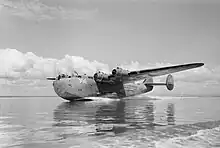
The last Pan Am 314 to be retired, the California Clipper NC18602, in 1946, had accumulated more than a million flight miles.[21] Of the 12 Boeing 314 Clippers built, three were lost to accidents, although only one of those resulted in fatalities: 24 passengers and crew aboard the Yankee Clipper NC18603 lost their lives in a landing accident at Cabo Ruivo Seaplane Base, in Lisbon, Portugal on February 22, 1943. Among that flight's passengers were prominent American author and war correspondent Benjamin Robertson, who was killed, and the American singer and actress Jane Froman, who was seriously injured.[22]
Pan-Am's 314 was removed from scheduled service in 1946 and the seven serviceable B-314s were purchased by the start-up airline New World Airways. These sat at San Diego's Lindbergh Field for a long time before all were eventually sold for scrap in 1950. The last of the fleet, the Anzac Clipper NC18611(A), was resold and scrapped at Baltimore, Maryland in late 1951.
BOAC's 314As were withdrawn from the Baltimore-to-Bermuda route in January 1948, replaced by Lockheed Constellations flying from New York and Baltimore to Bermuda.[23]
Variants
- Model 314
- Initial production version with 1,500 horsepower (1,100 kW) Twin Cyclone engines, six built for Pan Am.
- Model 314A
- Improved version with 1,600 horsepower (1,200 kW) Twin Cyclones with larger-diameter propellers, additional 1,200 US gallons (4,500 L; 1,000 imp gal) fuel capacity, and revised interior. Still air range approx 4,700 miles.[24] Six built, three for Pan Am and three sold to BOAC.
- B-314
- Five Model 314s pressed into military service with the U.S. Navy
- C-98
- Four Model 314s pressed into military service with the U.S. Army Air Forces
Operators
| Registration | Type | Name | In service | Remarks |
|---|---|---|---|---|
| NC18601 | 314 | Honolulu Clipper | 1939–1945 | Successfully landed 650 miles east of Oahu after losing power in two engines while flying for the US Navy on November 3, 1945. Aircraft mechanics from the escort carrier Manila Bay were unable to repair the engines at sea. The seaplane tender San Pablo attempted towing into port; but the flying boat was damaged in a collision with the tender and deliberately sunk on November 14 by Oerlikon 20 mm gunfire after salvage was deemed impractical.[2] |
| NC18602 | 314 | California Clipper | 1939–1950 | Flew from Auckland to New York in 1941–1942.[15] Sold to World Airways after World War II and was scrapped in 1950. |
| NC18603 | 314 | Yankee Clipper | 1939–1943 | Started transatlantic mail service. Crashed on February 22, 1943, when a wing hit the water during a turn on landing at Lisbon, Portugal. A total of 24 of 39 on board were killed.[25] |
| NC18604 | 314 | Atlantic Clipper | 1939–1946 | Purchased by the US Navy in 1942, but operated by Pan Am; salvaged for parts. |
| NC18605 | 314 | Dixie Clipper | 1939–1950 | Started transatlantic passenger service, later sold to World Airways. First presidential flight, when she flew Franklin D. Roosevelt to the Casablanca Conference in January 1943. Scrapped 1950. |
| NC18606 | 314 | American Clipper | 1939–1946 | Later sold to World Airways. Scrapped 1950. |
| NC18609 | 314A | Pacific Clipper | 1941–1946 | Temporarily named California Clipper to replace 18602 that was being moved to Atlantic service, renamed Pacific Clipper in 1942. Later sold to Universal Airlines. Damaged by storm and salvaged for parts. |
| NC18611 | 314A | Anzac Clipper | 1941–1951 | Sold to Universal Airlines 1946, American International Airways 1947, World Airways 1948. Sold privately 1951, destroyed at Baltimore, Maryland 1951. |
| NC18612 | 314A | Cape Town Clipper | 1941–1946 | Sold to US Navy 1942, American International Airways 1947. As the Bermuda Sky Queen she ran out of fuel while crossing the Atlantic on a westward flight, and ditched at sea about 500 miles east of Gander on October 14, 1947. After the rescue of all passengers and crew, she was sunk by the United States Coast Guard as a hazard to navigation.[26] |
| Registration | Type | Name | In service | Remarks |
|---|---|---|---|---|
| G-AGBZ | 314A (#2081) | Bristol | 1941–1948 | Originally NC18607, sold to General Phoenix Corporation, Baltimore as NC18607 in 1948 |
| G-AGCA | 314A (#2082) | Berwick | 1941–1948 | Originally NC18608, sold to General Phoenix Corporation, Baltimore as NC18608 in 1948. This aircraft flew both Winston Churchill and Lord Beaverbrook, Britain's Minister of Supply back urgently to the United Kingdom in mid-January 1942 after the British Prime Minister's extended stay in the United States following the attack on Pearl Harbor. Churchill was the first head of government to make a transatlantic crossing by plane.[27][28][29] |
| G-AGCB | 314A (#2084) | Bangor | 1941–1948 | Originally NC18610, sold to General Phoenix Corporation, Baltimore as NC18610 in 1948 |
Surviving aircraft
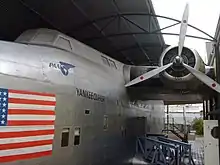
None of the dozen 314s built between 1939 and 1941 survived beyond 1951, with all 12 being cannibalized for parts, scuttled, scrapped, or otherwise written off. Underwater Admiralty Sciences, a non-profit oceanographic exploration and science research organization based in Kirkland, Washington, announced in 2005, at the 70th Anniversary of the first China Clipper flight in San Francisco, its plans to survey, photograph, and possibly recover the remains of the hulls of two sunken 314s: NC18601 (Honolulu Clipper), scuttled in the Pacific Ocean in 1945; and NC18612 (Bermuda Sky Queen, formerly Cape Town Clipper), sunk in the Atlantic by the Coast Guard in 1947. UAS has also spent significant time at Pan Am reunions and with individual crewmembers and employees of Pan Am conducting videotaped interviews for the mission's companion documentary.[30][31] However, as of 2014, no search or recovery had been attempted, with the most recent news from 2011 suggesting that the company was still in need of at least US$8 million to get the plan under way.[32]
There is a life-size 314 mockup at the Foynes Flying Boat Museum, Foynes, County Limerick, Ireland, located on the site of the original transatlantic flying-boat terminus.[33]
Specifications (314A Clipper)
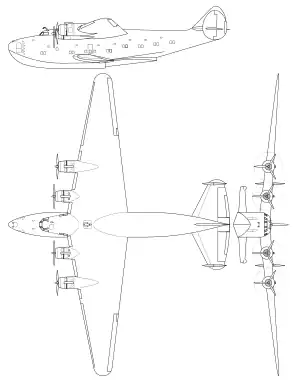
Data from Jane's Fighting Aircraft of World War II[34]
General characteristics
- Crew: 11, including 2 cabin stewards
- Capacity: 68 day passengers and/or 36 sleeping passengers / 5 short tons (4,536 kg) of mail and or cargo
- Length: 106 ft (32 m)
- Wingspan: 152 ft (46 m)
- Height: 20 ft 4.5 in (6.210 m)
- Airfoil: root: NACA 0018; tip: NACA 0010[35]
- Empty weight: 48,400 lb (21,954 kg)
- Gross weight: 84,000 lb (38,102 kg)
- Fuel capacity: 5,408 US gal (4,503 imp gal; 20,470 L) in wing and sponson tanks
- Powerplant: 4 × Wright 709C-14AC1 Twin Cyclone 14-cylinder air-cooled radial piston engines, 1,600 hp (1,200 kW) each
- Propellers: 3-bladed Hamilton Standard fully-feathering constant-speed propellers
Performance
- Maximum speed: 210 mph (340 km/h, 180 kn) at 6,200 ft (1,890 m)
- Cruise speed: 188 mph (303 km/h, 163 kn) at 66.5% power at 11,000 ft (3,353 m)
- Range: 3,685 mi (5,930 km, 3,202 nmi) normal
Cultural influence
Inspired by the airplane, Smith Corona designed, manufactured, and marketed a typewriter model they called the Clipper from 1945–1960. The typewriter model's logo prominently featured the Boeing 314 Clipper on the typewriter's body which served as a reminder of the luxury and design of the original airplane.[36]
See also
Related development
Aircraft of comparable role, configuration, and era
Related lists
References
Notes
- Bowers 1977b, pp. 14–15
- Bogash, Robert A. "In Search of an Icon: The Hunt for a Boeing B-314 Flying Boat, Pan American NC18601 – the Honolulu Clipper". Trains, Planes, and...... Retrieved July 31, 2011.
- Bowers 1977a, pp. 28–35, 60–61
- Roemer, Nathan (2003). "British Airways Concorde". The Travel Scholar. Sound Message, LLC. Retrieved August 19, 2006.
- Klaás 1989, p. 20
- Klaás 1989, p. 64
- Masland, William M. (1984). Through the Back Doors of the World in a Ship That Had Wings. New York: Vantage Press. ISBN 0-533-05818-X.
- "FAM Foreign Air Mail First Flights F14". Aerodacious. June 25, 2007.
- "Transoceanic Travel and the Pan American Clippers". The Flying Clippers. Archived from the original on November 11, 2005.
- Pomata, Anthony E. (April 21, 2001). "Boeing's Model 314 Clipper Flying Boat". HistoryLink.org.
- Klaás 1989, pp. 17, 20
- Balfour, Harold (1973). Wings over Westminster. London: Hutchinson. pp. 141–155. ISBN 0091143705.
- Follett, Ken (1991). "Author's Note". Night over water. New York: William Morrow and Company. p. 399. ISBN 0-688-04660-6. LCCN 91017701.
- Hardesty 2003, pp. 37–41
- Bull, John (August 2014). "The Long Way Round: The Plane that Accidentally Circumnavigated the World". Lapsed Historian. Medium.com. Retrieved September 6, 2020.
- Brock 1978, chapter VI
- Swanborough, Gordon; Bowers, Peter M. (1976). United States Navy Aircraft since 1911 (2nd ed.). Annapolis, Maryland: Naval Institute Press. p. 416. ISBN 0-87021-968-5.
- Wolfert, Ira (February 8, 1942). "Feminine 'Grease Monkeys' Girls Tune Up Giant Planes". The Miami News. p. 1.
- "[Airport] Building Equipment: Heating, Lighting, Power, Service Outlets." (New) Pencil Points, February 1943, 61.
- Brock 1978, p. 224 Brock also reports cheap postwar availability to Pan Am of DC-4s and "Connies" was an important factor.
- Klaás 1990, p. 78
- Klaás 1993, pp. 16–18
- "Corporations' Annual Reports : B.O.A.C." Flight: 634. November 25, 1948. Archived from the original on March 5, 2016.
- "From Pan Am to BOA: First of three Boeing 314—As now on British Empire Routes". Flight. June 26, 1941. Archived from the original on June 17, 2019. Retrieved August 2, 2011.
- "ASN Aircraft accident Boeing 314A NC18603 Lisboa". Aviation Safety Network. Retrieved August 2, 2011.
- Morris, Ted. "Air-Sea Rescue at Ocean Station Charlie: The Bibb & Bermuda Sky Queen". The collected articles and photographs of Ted A. Morris, Lieutenant Colonel, U.S. Air Force, Retired. Archived from the original on July 3, 2010. Retrieved July 31, 2011.
- Roberts, Andrew (2018). Churchill: Walking with Destiny. London: Allen Lane (Penguin). pp. 707, 708. ISBN 978-0-241-20563-1.
- Lavery, Brian (2007). Churchill Goes to War: Winston's Wartime Journeys. Annapolis, Maryland: The Naval Institute Press. p. 94. ISBN 978-1-59114-103-7.
- Kelly Rogers, John Cecil (February 2, 1942). "The Churchill Flight: His Pilot Reports the Trip to England". Life. pp. 28, 30.
- Allen, Mark; Johnston, Jeff (November 2005). "Seattle Company Announces Search for Pan American Airways Flying Boat" (PDF). Clipper Discovery Update: Underwater Admiralty Sciences Newsletter. pp. 1, 12. Archived from the original (PDF) on May 21, 2011. Retrieved September 16, 2009.
- Johnston, Jeff (July 2007). "Project Update" (PDF). Clipper Discovery Update: Underwater Admiralty Sciences Newsletter. pp. 1, 9. Archived from the original (PDF) on September 30, 2011. Retrieved September 16, 2009.
- Bartly, Nancy (September 25, 2011). "Money sought to retrieve submerged Boeing Flying Clippers". The Seattle Times. Archived from the original on June 7, 2014. Retrieved June 5, 2014.
- "Our Replica". Foynes Flying Boat Museum. Archived from the original on January 20, 2011. Retrieved December 2, 2007.
- Bridgeman 1989, p. 211
- Lednicer, David. "The Incomplete Guide to Airfoil Usage". UIUC Airfoil Data Site. UIUC Applied Aerodynamics Group. Retrieved April 16, 2019.
- "Smith Corona Typewriter Serial Numbers". The Typewriter Database. Retrieved April 17, 2023.
Sources
- Bowers, Peter M. (November 1977a). "The Great Clippers, Part I". Airpower. 7 (6).
- Bowers, Peter M. (December 1977b). "The Great Clippers, Part II". Wings. 7 (6).
- Bridgeman, Leonard (1989). The Boeing 314-A Clipper. ISBN 1-85170-493-0.
{{cite encyclopedia}}:|work=ignored (help) - Brock, Horace (1978). Flying the Oceans: A Pilot's Story of Pan Am, 1935–1955 (3rd ed.). New York: Jason Aronson, Inc. ISBN 0-87668-632-3.
- Dorr, Robert F. (2002). Air Force One. New York: Zenith Imprint. ISBN 0-7603-1055-6.
- Dover, Ed. The Long Way Home: A Journey into History with Captain Robert Ford. Archived 2019-07-01 at the Wayback Machine Albuquerque, New Mexico: Amazon POD, Revised Edition 2010, First edition 2008. ISBN 978-0-615-21472-6.
- Hardesty, Von (2003). Air Force One: The Aircraft that Shaped the Modern Presidency. Chanhassen, Minnesota: Northword Press. ISBN 1-55971-894-3.
- Klaás, M. D. (December 1989). "Clipper Across the Pacific, Part One". Air Classics. 25 (12).
- Klaás, M. D. (January 1990). "Clipper Across the Pacific, Part Two". Air Classics. 26 (1).
- Klaás, M. D. (February 1993). "Clipper Flight 9035". Air Classics. 29 (2).
- Klaás, M. D. (June 1969). "The Incredible Clippers". Air Classics. 5 (5).
- Klaás, M. D. (April 1991). "When the Clippers Went to War". Air Classics. 27 (4).
- "Towards the Flying Ship – Details of the Boeing 314 or Atlantic Clipper: A 100-passenger Successor?". Flight: 67–68. July 21, 1938. Archived from the original on November 7, 2017.
- Yea, Hugh J. (1991). "Talkback". Air Enthusiast. No. 44. pp. 79–80. ISSN 0143-5450.
External links
- Boeing: Historical Snapshot: Model 314 Clipper Flying Boat
- The Boeing 314
- Pan American Clippers 1931–1946
- Boeing 314
- Boeing 314
- Boeing 314 Archived February 11, 2021, at the Wayback Machine
- LIFE colour photo camouflaged Clipper La Guardia Marine Terminal ca.1942
- LIFE photo essay (comprehensive)'Pan American Clipper Ship' includes NC18605 in a glass doored hangar 1940
- LIFE photo Pan Am skipper flying the 314
- LIFE photo essay 'Pan American Clipper'includes Eve Curie leading pax off Clipper at Lisbon 1940
- LIFE photos NC18602 in Singapore Harbour 1941
- China Clipper 75th Anniversary Commemorative Flight (November 2010 – San Francisco Aeronautical Society)
- "Two Day Turn Around", February 1941 article
- "Three Deck Clipper Has Aisle In Wings", Popular Mechanics, August 1937, early article on Pan American Airways new airliner for trans-ocean flight
- "New York To Europe By Clipper", Popular MechanicsMay 1939, large article with cutaway drawing of interior
- "Sailors of the Sky", Popular Mechanics, December 1940, detailed article with photos on flight deck operations of the Boeing 314